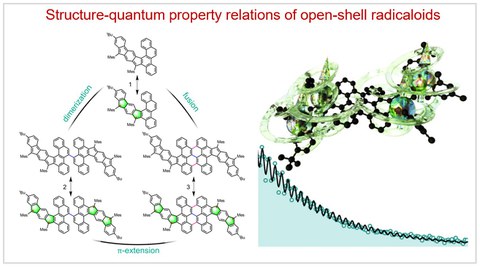13.07.2021
Synthetic tuning of the quantum properties of open-shell radicaloids
Molecular compounds are emerging as appealing units for quantum computation and quantum technologies. For these purposes open-shell molecular radicaloids hold exceptional interest: they offer π-conjugated units with an unpaired electron ground state and they can be considered as atomically-precise pieces of graphene. The next frontier to improve the quantum performance is to determine structure-quantum properties relations, such as how the size of the extended π-systems affects the coherence properties, or how the molecular geometry and electron-nuclear interactions determine the coherence time, so as to channel the synthetic efforts towards blocking decoherence pathways.
The scientists from TU Dresden/Oxford university have established the links between morphology and quantum properties, using three related radicaloids (1, 2 and 3) based on meta-quinodimethane. The roles of the π-conjugated backbone and of the side groups on the spin-flip and quantum coherence times are unraveled. The temperature regions are identified, where different structural parts of the molecule or solvent become the dominant decoherence channel. The record quantum coherence values obtained at room temperature are still well below the intrinsic limits of radicaloids, and the researchers further discuss the directions to optimize the quantum performance. This fruitful work of the joint research has been now published in the renowned journal “Chem” as an article.
Acknowledgments: The authors gratefully acknowledge financial support by the EU Horizon 2020 (ERC-CoG-MMGNRs-773048 and ERC-CoGT2DCP-881603, Graphene Flagship Core3 813036, Marie-Curie program), Royal Society (RS grant and URF), EPSRC (grant no. EP/N509711/1, EP/R042594/1, and EP/L011972/1), German DFG (Cluster of Excellence ‘‘Center for Advancing Electronics Dresden (cfaed)’’) and EnhanceNano-391979941, the European Social Fund and the Federal State of Saxony (ESFProject ‘‘GRAPHD,’’ TU Dresden).

